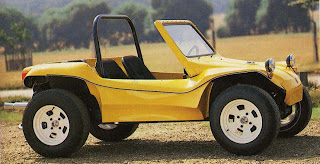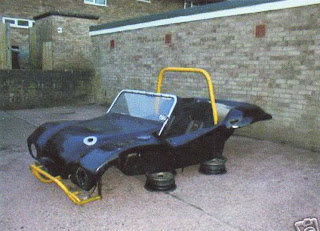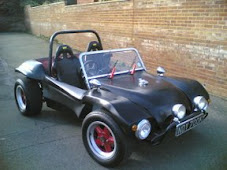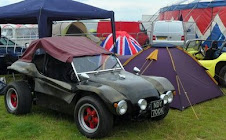25th Feb 2010.
My starter motor was now working and I was able to start my engine after the jetting and the new 28mm Chokes had been fitted last month. This was the first time I had been able to check this as my starter motor failing had meant I could not determine if the changes where better and the engine would run. My first tests with the faulty starter motor indicated that it would not fire.
The results can be seen from the video I think its a definite improvement and took the car out for a test driver. It was quite noticeable that the car had acceleration but also had a small acceleration hole just after you pressed the throttle. I also had problems climbing up a steep hill so returned to the garage and jacked up the rear of the car up and found that the rear wheels where very stiff to turn. I left the buggy for an hour over lunch and returned to find that the wheels turned freely again. I presumed this was the brakes sticking and although I tried to emulate this again could not get the brakes to stick . I subsequently took the car out two more times without any problems.
Replacing A VW Starter motor bush
 24th March 2012
24th March 2012I knew my starter motor had failed with a broken winding and thought that it was likely that this was due to a worn starter motor bush that had caused the windings to hit one of the magnets.
There are two types of starter motor bush one which is a 12v bush and another which is a 6v bush that converts to a 12v starter motor. It is important to get the correct one.
The starter motor is fastened b
 y only two bolts top and bottom the top goes right through the engine casing whist the bottom is a short stud. It is very important not to loose the top bolt as it has an unusual D shape end. Once removed the hole in the gearbox can be seen and the b
y only two bolts top and bottom the top goes right through the engine casing whist the bottom is a short stud. It is very important not to loose the top bolt as it has an unusual D shape end. Once removed the hole in the gearbox can be seen and the b ush contained in the centre. A 12mm tapered tap can be wound into the bearing by hand so that it starts to bite I used a pair of grips on the end of the tap so that it could be turned in the small space as the tap handle did not have enough room to turn. You need to keep turning the tap until it bottoms out on the hole. This need quite a few turns to complete but eventually the bearing moved up on the tap and out of it hole.
ush contained in the centre. A 12mm tapered tap can be wound into the bearing by hand so that it starts to bite I used a pair of grips on the end of the tap so that it could be turned in the small space as the tap handle did not have enough room to turn. You need to keep turning the tap until it bottoms out on the hole. This need quite a few turns to complete but eventually the bearing moved up on the tap and out of it hole.
You can see from the picture right that the bearing has been wound onto the tap with the depth of the tap protruding from the end of the bearing being the depth of the hole from which it came from. I tried the new bearing on the end of the tap and noticed that it slipped easily on and off without interference. I decided that I could use the tap to replace the new bearing . I greased up the new bearing and slid it onto the tap. I
 removed the adjustable and sat the whole assembly in the hole. I used a rubber mallet to softly tap the end of the tap and the new bearing into place. The tap was then slid back out to leave the bearing in place see picture right. This whole procedure took a very short time and to be honest I would recommend replacing this bearing if you are replacing a starter motor. The replacement starter motor was refitted . It can take a little time to mesh the gears when refitting this may involve using someone to turn the engine or you will have to move the starter gear and replace the motor until it goes completely in. The two bolts were replaced and torqued up. The wiring on the back of the solenoid was reconnected and the job was complete.
removed the adjustable and sat the whole assembly in the hole. I used a rubber mallet to softly tap the end of the tap and the new bearing into place. The tap was then slid back out to leave the bearing in place see picture right. This whole procedure took a very short time and to be honest I would recommend replacing this bearing if you are replacing a starter motor. The replacement starter motor was refitted . It can take a little time to mesh the gears when refitting this may involve using someone to turn the engine or you will have to move the starter gear and replace the motor until it goes completely in. The two bolts were replaced and torqued up. The wiring on the back of the solenoid was reconnected and the job was complete.
Labels:
Starter Motor,
Starter Motor Bush
Dismantleing a VW Starter motor
 23rd Feb 2012
23rd Feb 2012My starter motor had been sourced from Volkszone and seemed to be taking some considerable time to reach me due in some part to the snow and late posting.
I decided that I would remove the old starter and see if the damage was repairable . The starter motor is fastened by only two bolts top and bottom the top goes right through the engine casing whist the bottom is a short stud. It is very important not to loose the top bolt as it has an unusual D shape end.

 The starter motor can be took part very easily. The end cover is secured by two small screws . This covers the main shaft which is held in place by a U shape washer and several shims. The Shims are very important as they set the amount of float on the starter motor. Once these have been removed the two larger bolts can be removed allowing the outer casing to be withdrawn from the main shaft. The four carbon brushes could then be inspected in the starter motor cover. Mine was in very good shape and I knew this could not
The starter motor can be took part very easily. The end cover is secured by two small screws . This covers the main shaft which is held in place by a U shape washer and several shims. The Shims are very important as they set the amount of float on the starter motor. Once these have been removed the two larger bolts can be removed allowing the outer casing to be withdrawn from the main shaft. The four carbon brushes could then be inspected in the starter motor cover. Mine was in very good shape and I knew this could not be the problem . I turned my attention to the main shaft and the copper windings and the contact areas on the commutator . It is noticeable on my copper windings that one of the copper windings is broken and does not make contact with the starter motor. I had found the reason for the motor failure. Several days past before my replacement starter motor eventually turned up . The package was split open and the delivery agent for Parcel Force stated it was not suitably wrapped. However the item had not suffered any damage and power up from a battery and starter cables quite successfully.
be the problem . I turned my attention to the main shaft and the copper windings and the contact areas on the commutator . It is noticeable on my copper windings that one of the copper windings is broken and does not make contact with the starter motor. I had found the reason for the motor failure. Several days past before my replacement starter motor eventually turned up . The package was split open and the delivery agent for Parcel Force stated it was not suitably wrapped. However the item had not suffered any damage and power up from a battery and starter cables quite successfully. The starter motor was painted but appeared to be rusting underneath the paint. I decided to clean the starter motor down with and electric Wire brush. The paint and rust stripped back quite easily leaving a smooth bare metal appearance . I painted the Starter motor and refitted my old solenoid to the side as I knew my solenoid was newer. I tested the starter motor again and it all functioned correctly.
The starter motor was painted but appeared to be rusting underneath the paint. I decided to clean the starter motor down with and electric Wire brush. The paint and rust stripped back quite easily leaving a smooth bare metal appearance . I painted the Starter motor and refitted my old solenoid to the side as I knew my solenoid was newer. I tested the starter motor again and it all functioned correctly.My starter motor windings had failed and I knew I should replace the starter bush before replacing the starter on the car.
Labels:
Starter Motor
Jetting Delorto DRLA 40 Twin Carburettors
 3rd Feb 2012
3rd Feb 2012My 40mm/28mm chokes had turned up from Italy and I was very pleased to see that when they arrived they were in fact the correct parts I had ordered. I had been previously trying to cure the jetting problems of my carburetors where my engine was idling well but had a lack of acceleration that could be resolved by pumping the throttle. I had believed that this was because of the size of my idle and main jets but had been told by both VW Heritage and Dellorto UK that it was more likely that my chokes being 40mm/32mm where the wrong size for my engine and was likely to be the cause of the jetting issues.
To fit the chokes into th
 e DRLA40 carburetors is a fairly straight forward procedure, First the cross bar linkage needs to be removed . This is best achieved by unscrewing one of the ball ends that attach to the carburetor linkage plates. This has the result in making the bar shorter in length and able to be removed. The connecting rods then need to be removed from the carburetors so that it can be pulled out. You can carefully pull the bar out of the way to gain access which is the route took. To change the chokes you need to disassemble both Carburetors, it is usually safer to do this one at a time and rebuild so as not to muddle up parts. The Dellorto DRLA 40 carburetor is built up from the top . This means first the linkage bar plate needed to be removed by the four screws that held it in place. After this has been removed a gasket can be easily removed from the top of the Carburetor to expose the four inlayed bolts that hold the top of the carburetor on. Great care should be excorsied as the top plate holds the gasket and the float assembly . When separating the top from the body of the carburetor ensure that the gasket does not get trapped. It is sometimes easier in tight positions to remove the fuel line first.
e DRLA40 carburetors is a fairly straight forward procedure, First the cross bar linkage needs to be removed . This is best achieved by unscrewing one of the ball ends that attach to the carburetor linkage plates. This has the result in making the bar shorter in length and able to be removed. The connecting rods then need to be removed from the carburetors so that it can be pulled out. You can carefully pull the bar out of the way to gain access which is the route took. To change the chokes you need to disassemble both Carburetors, it is usually safer to do this one at a time and rebuild so as not to muddle up parts. The Dellorto DRLA 40 carburetor is built up from the top . This means first the linkage bar plate needed to be removed by the four screws that held it in place. After this has been removed a gasket can be easily removed from the top of the Carburetor to expose the four inlayed bolts that hold the top of the carburetor on. Great care should be excorsied as the top plate holds the gasket and the float assembly . When separating the top from the body of the carburetor ensure that the gasket does not get trapped. It is sometimes easier in tight positions to remove the fuel line first. With the top removed the DRLA 40 Auxiliary venturi can be removed . These are held in with two screws and a clocking nut at the front and back of the carburetor. Pictured right the screw hole with the top positioned on the carburetor . Once the nut has been loosened a screw driver can be used to undo and remove the bolt once these have been withdrawn th
With the top removed the DRLA 40 Auxiliary venturi can be removed . These are held in with two screws and a clocking nut at the front and back of the carburetor. Pictured right the screw hole with the top positioned on the carburetor . Once the nut has been loosened a screw driver can be used to undo and remove the bolt once these have been withdrawn th e Auxiliary venturi pictured right can be removed. It is important to notice that the Auxilary venturi are handed and have different opposing sides . When re inserting the Auxillary venturi you must ensure the face with the o ring is positioned towards the centre of the carburetor otherwise the acceleration fuel jet will not be able to work correctly. When you have removed the Auxiliary venturi the chokes may be withdrawn from the carburetor twin barrels.
e Auxiliary venturi pictured right can be removed. It is important to notice that the Auxilary venturi are handed and have different opposing sides . When re inserting the Auxillary venturi you must ensure the face with the o ring is positioned towards the centre of the carburetor otherwise the acceleration fuel jet will not be able to work correctly. When you have removed the Auxiliary venturi the chokes may be withdrawn from the carburetor twin barrels. The barrels of the carburettor should look similar to the picture left. You should check the throats of both barrels are clean with a lint cloth. The 40mm/28mm chokes can then be lightly lubricated and placed back in the carburetor one in each barrel with the size stamp facing upper most . Once these have been seated . You can place the Auxiliary venturi back in the to throat above the choke it is important to ensure the rubber o ring on one side of the venturi is facing towards the main jets. With both venturi in place the securing screws can be re inserted and tightened to hold the venturi in place . It can bee seen that if teh screw does not hold the venturi tightly then the venturi is reversed and will need to be removed and fitted correctly with the o ring towards the main jets.The locking nuts can then be placed on the venturi securing screws and tightened. The top of the carburetor can then be refitted ensuring that the gasket is trapped correctly between the two parts. This can be a fiddle as there is a little spring that sits on top of the choke unit that can interfere with the refitting process. Once the top is positioned it can be re bolted back together with the four bolts. The gasket can then be placed back on top and the linkage plate can then be positioned on top with the washers , spring washers and nuts. The Air Cleaner can be re fitted and the other carburetor can then be attended to in the same way.
The barrels of the carburettor should look similar to the picture left. You should check the throats of both barrels are clean with a lint cloth. The 40mm/28mm chokes can then be lightly lubricated and placed back in the carburetor one in each barrel with the size stamp facing upper most . Once these have been seated . You can place the Auxiliary venturi back in the to throat above the choke it is important to ensure the rubber o ring on one side of the venturi is facing towards the main jets. With both venturi in place the securing screws can be re inserted and tightened to hold the venturi in place . It can bee seen that if teh screw does not hold the venturi tightly then the venturi is reversed and will need to be removed and fitted correctly with the o ring towards the main jets.The locking nuts can then be placed on the venturi securing screws and tightened. The top of the carburetor can then be refitted ensuring that the gasket is trapped correctly between the two parts. This can be a fiddle as there is a little spring that sits on top of the choke unit that can interfere with the refitting process. Once the top is positioned it can be re bolted back together with the four bolts. The gasket can then be placed back on top and the linkage plate can then be positioned on top with the washers , spring washers and nuts. The Air Cleaner can be re fitted and the other carburetor can then be attended to in the same way.The linkage kit can be fitted into the linkage plate on one side and the ball joint tightened to remove any play.
Current DRLA 40 jets
Chokes 40mm/28mm Ventri
Main 112
AC 180
Emulsiontube 9164.4
Idle 60
Pumps 35
I was unable to test my new installation as I discovered that my Starter motor had failed.
Subscribe to:
Posts (Atom)


















